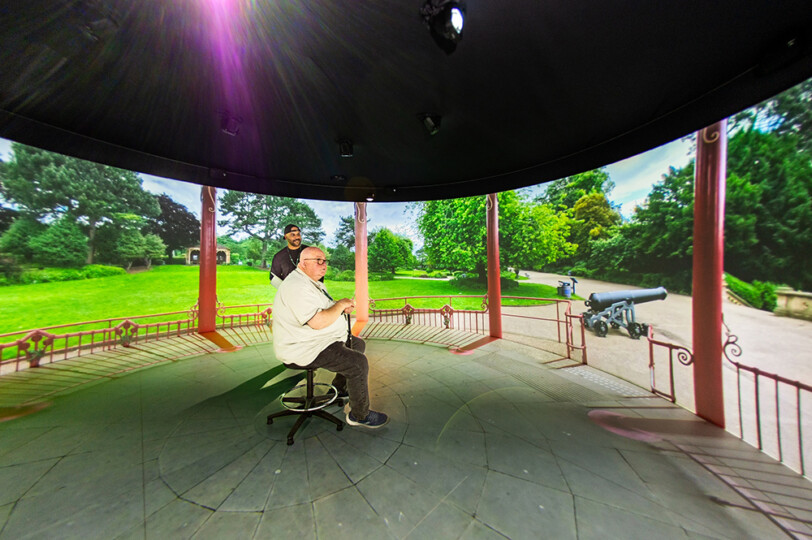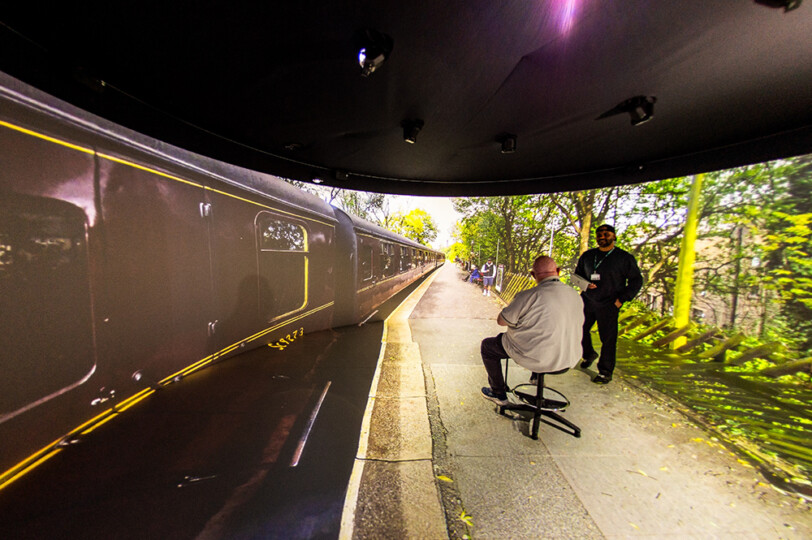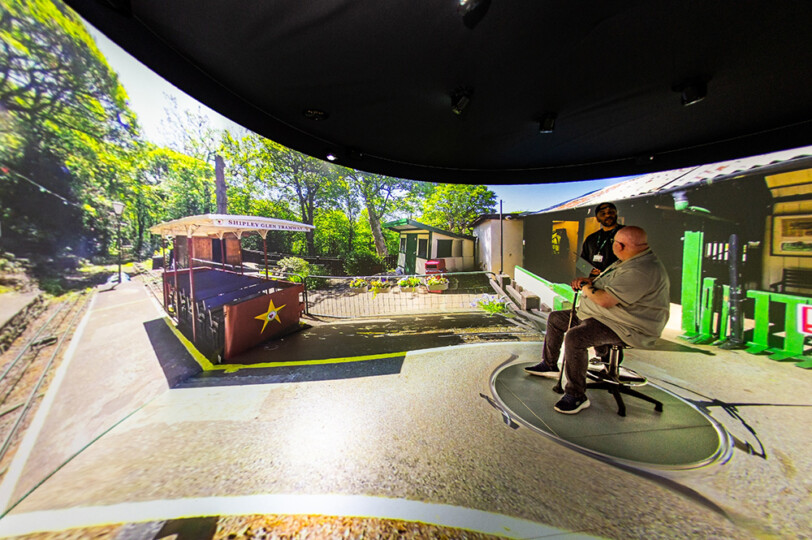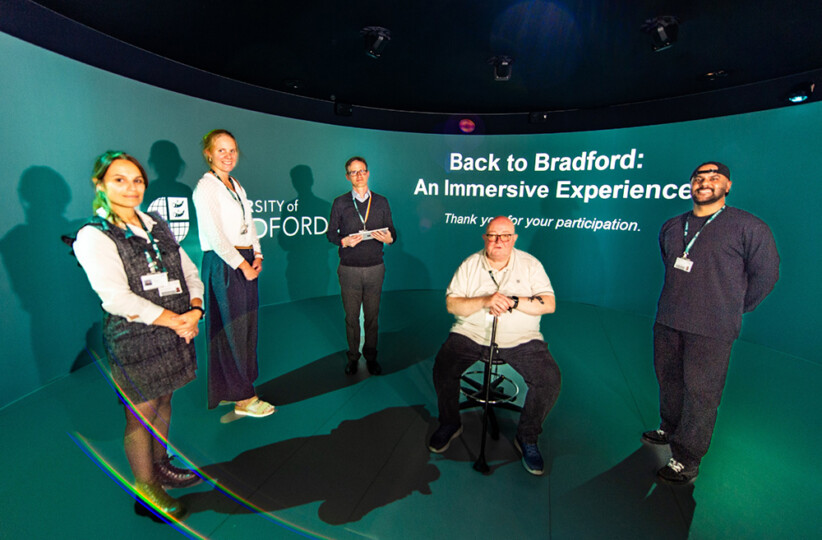People with dementia step inside iGloo to boost wellbeing
An innovative project using a 360-degree immersive room showing images of Bradford landmarks to help the wellbeing of people with dementia has been launched by the University of Bradford.
‘Back to Bradford: An Immersive Experience’ sees people with dementia enter the University’s iGloo, a seven-metre 360-degree floor-to-ceiling immersive learning space, to view a presentation of images from Bradford’s past and present.

Roberts Park in Saltaire is one of the images featured in the immersive technology experience. Images credit: Kiran Mehta @ KM Images Ltd
The project aims to help people with dementia share their memories, feelings and thoughts produced from viewing the images.
The presentation includes a carousel of photographs and videos of Bradford district landmarks and moments, including a blue Bradford trolleybus, an aerial view of a rugby league match played at Odsal Stadium in 1947, Shipley Glen Tramway, the 1973 demolition of Bradford’s original Kirkgate Market, and a video of a steam train arriving at Haworth Station.

A steam train arriving at Haworth Station is also included. Images credit: Kiran Mehta @ KM Images Ltd
Reactions to the images
People with dementia were invited into the University’s iGloo for two sessions.
Michael Andrews, who was diagnosed with a rare type of dementia called Posterior Cortical Atrophy in 2017, and moved to Bradford from Northern Ireland in 1989, said: “The photograph of the Bradford riots brought back memories for me.
“It’s a good project for people with dementia and it will help to bring back memories for the older generation. I enjoyed seeing the older images of Bradford.”

Michael Andrews views Shipley Glen Tramway. Images credit: Kiran Mehta @ KM Images Ltd
The project’s aims
Reminiscence activities are known to improve mood, social engagement, and wellbeing for people with dementia. But the use of immersive technologies for this purpose has not been widely studied.
Dr Ana Barbosa, Senior Research Fellow, Centre for Digital Innovations in Health and Social Care at the University of Bradford, and her team are capturing the participant’s feedback and reactions through eye tracking technology, audio recording of their discussions in the iGloo and regular interviews.
She said: “The project helps to trigger positive memories and promote and improve the mood of people with dementia. It is an example of the University of Bradford using digital innovations to promote wellbeing.
“We want to use immersive technology as a therapeutic tool, not just for people with dementia, but also with other vulnerable populations.”

From left, Dr Ana Barbosa, Erica Bellamy, Professor Andrew Wilson, Michael Andrews and Hasnehn Haider inside the iGloo. Images credit: Kiran Mehta @ KM Images Ltd
Connecting people to their memories
Erica Bellamy, the University’s Director of Digital Health and Social Care, says the project is an example of how digital health can be transformative.
She said: “Immersive technologies offer a powerful way to connect people to their memories, their communities, and each other.
“By stepping into familiar places through digital projection, participants can experience moments of joy, reflection, and emotional connection.
“This project exemplifies how digital innovation can create inclusive, meaningful cultural experiences, support wellbeing while advancing our understanding of dementia care.”
Hasnehn Haider, the University’s Immersive Learning Lead, said: “Capturing the real-world places and spaces, using specialist 360-degree camera equipment, enabled me to really connect with the project.
“From Haworth to Saltaire, and eventually to the centre of Bradford, these places have real significance for so many people who have walked those paths. Dovetailing the past with the present adds another dimension to the immersive experience.”
More on the iGloo
The iGloo was one of the first installations to offer 360-degree immersivity with floor projection, creating an ultra-realistic experience. This was made possible by funding from the Arts & Humanities Research Council Capability for Collections Scheme (CapCo) via an award to Archaeology & Forensic Sciences linked to City of Culture, with support for installation through a joint business case between Digital Health & Social Care and Archaeology & Forensic Sciences.
Professor Andrew Wilson, Chair in Forensic & Archaeological Sciences at the University, said: “The iGloo serves as a visualisation tool for Humanities-led research and engagement, and it is great to have cross-disciplinary research utilising this immersive space.
“Rich partnerships with colleagues in health, dementia and social care illustrate the potential of research collaboration, drawing upon longstanding expertise from the Visualising Heritage team within Archaeology & Forensic Sciences.”
This innovative dementia project reflects the University of Bradford’s commitment to using digital technology to improve lives and support wellbeing. By combining immersive learning with health research, it shows how the University is working across disciplines to create inclusive, impactful solutions for real-world challenges. It also highlights the University’s focus on community engagement and cultural heritage, aligning with its strategy to be a place of social innovation and transformation.

